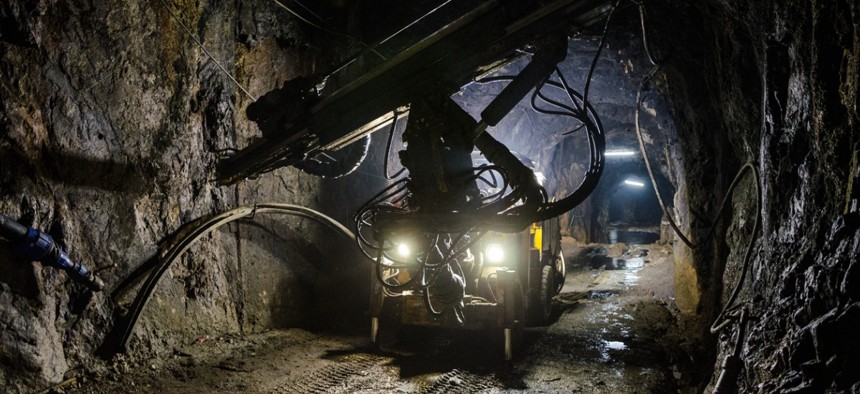Military Robots Dig into New Underground Environments

Juan Jose Napuri/iStock.com
Only a few organic creatures specifically designed for that environment are able to do it well.
When you think of military robots or drones, images of unmanned aircraft that have been patrolling the skies in combat zones for many years like the durable Predators or Reapers probably come to mind. Or you might think about even more advanced flying machines like the autonomous Skyborg being designed for the Air Force to act as a wingman to human pilots in combat situations. Flying drones are so popular and well established these days that there are even hundreds of models available for civilian use.
Designing drones that can fly makes a lot of sense, because other than during takeoffs and landings, it’s easy to keep them from coming into contact with the ground or any of the many hazards that can impact travel on land. Once you get a flying drone above the treetops, there is not too much to worry about in terms of things that the aircraft can crash into.
Then about five years ago, we started to see drones and robots evolving into new environments, specifically with many being engineered to conquer the underwater world. Right now, most underwater robots are designed for maintenance, various surveillance or scientific tasks, or simply for exploration. But if you think about it, drones swimming in the ocean makes a lot of sense too, because like the drones that can fly, there is not too much for them to run into once launched.
Recently, the U.K. military held large exercises where swarms of drones and other autonomous vehicles were tested in various combat roles. Some even bridged the gap between sea and sky, diving down into the water and swimming for a while before zooming back up into the sky to complete their missions.
But if there is one place that gives drones trouble, it’s the ground, or more specifically, the underground. Moving and operating underground isn’t an easy task. Only a few organic creatures specifically designed for that environment like earthworms, ants and moles are able to do it well. Creating a functional robot that can dig its own path seems almost impossible. And yet, the Defense Advanced Research Projects Agency came up with quite a few potential uses for a robot that could navigate underground.
It announced the Underminer program last year, tasking three organizations with trying to develop a tunneling robot that could navigate the underground world without human intervention. According to DARPA, the goal of the program was to “develop and demonstrate tactical uses for rapidly created underground infrastructure in contested environments.” Dr. Andrew Nuss, the Underminer program manager in DARPA’s Tactical Technology Office said: “The ability to quickly bore tactical tunnels could benefit contingency operations such as rapid ammunition resupply, rescue missions or other immediate needs.”
This week, scientists working at the GE Research testing site in Niskayuna, New York successfully deployed one of the first and most impressive digging robots in the world. Funded with $2.5 million from the DARPA Underminer program, the scientists at GE were able to task their robot with quickly digging a small tunnel under their research facility’s grounds. The robot operated independently without human intervention during the test.
Unlike most robots with rigid bodies designed to protect their vulnerable electronics housed inside, the GE robot has a soft body that resembles an earthworm with lots of articulated joints. This gives the robot the strength to push through soft ground, but also to make very tight turns in a way that is impossible for solid drill bits and most other modern digging technology. When you look at the robot navigating through a clear tube set up by the researchers to study its locomotion, it really does look like a giant earthworm.
According to GE, the worm robot is capped with a piloting tool on its nose designed to stir and soften the ground as it moves forward. As the dirt loosens, the inside of the worm begins to churn in a way that mirrors how earthworms navigate their underground environment. Fluid flows through seven internal chambers that act as muscles, flexing as water is pumped in and out of them. To move forward, a swelling hydraulic muscle inflates, anchoring the tail of the robot while the auger churns at the head. The worm then elongates to push itself forward.
The worm is equipped with ultrasound technology which allows it to track its movements as well as the angle and position of the entire robot. GE has gone through several prototypes prior to this model. Future worms might be even smarter, able to quickly navigate to wherever they are needed to carry out missions.
The new DARPA-funded worm robot proves that autonomous, robotic vehicles have a bright future in both the military and civilian organizations. Having conquered the sky, the seas and now the underground, there is almost nothing that can stop them from continuing to advance and complete increasingly complex missions in almost any environment.
John Breeden II is an award-winning journalist and reviewer with over 20 years of experience covering technology. He is the CEO of the Tech Writers Bureau, a group that creates technological thought leadership content for organizations of all sizes. Twitter: @LabGuys



